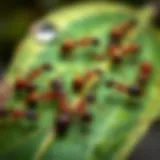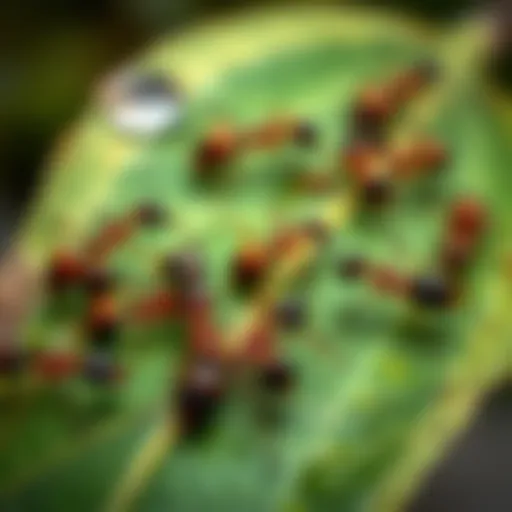Understanding Responsible Pest Control Pricing Strategies


Intro
When it comes to keeping our homes free from annoying pests, the first thing that usually springs to mind is the cost of pest control services. Understanding pricing in this field is as complicated as deciphering a secret code. It’s important to remember that the prices for pest control services can greatly vary based on several factors. In this article, we delve into the intricacies of pest control pricing. We will explore everything from the biology of pests to the methodologies employed for their control, encompassing traditional and eco-friendly practices.
The crux of responsible pest control lies not just in elimination but in prevention and sustainability. With the growing awareness of environmental concerns, more homeowners are looking for methods that are not only effective but also environmentally friendly. Knowing the price ranges associated with these services can help you make informed, thoughtful decisions. As we navigate through this guide, expect to learn valuable insights that can aid any homeowner or professional in understanding the delicate balance between cost and effective pest management.
Understanding the Pest
To grasp how pest control pricing works, the first step is understanding the pests that invade our spaces.
Identification
Every pest from ants to rodents has its unique characteristics and behaviors. Identifying the specific type of pest can significantly impact treatment plans and costs. For instance, a termite infestation might require extensive repairs and specialized treatments, yielding a steeper price compared to a simple ant problem.
Commonly encountered pests include:
- Rodents – Mice and rats often invade homes, searching for food and shelter.
- Insects – This category includes spiders, ants, and cockroaches, all demanding different control strategies.
- Termites – Known for their destructive nature, these pests are often the most costly to manage.
- Bed Bugs – These insects have gained prominence in recent years, presenting complex challenges for eradication.
Life Cycle
Understanding a pest's life cycle offers critical insights into effective control methods. A pest's reproductive rate, habits, and seasonal behaviors inform the timing and type of control needed. For instance, knowing that a certain pest breeds rapidly during warm months can dictate the urgency of treatment. Control methods may become more complex, thus potentially raising costs, if not executed at the right time.
"The more you understand the enemy, the better prepared you are to battle it."
Pest Prevention Strategies
Implementing prevention strategies can vastly reduce the need for expensive interventions later on. Here are some practical steps:
Environment Modification
A well-kept environment deters pests effectively. Factors such as moisture control and sanitation play crucial roles in keeping pests at bay. Reducing clutter and properly sealing cracks in walls can make your home less appealing. Therefore, even though initial adjustments like these may incur a small cost, they are often cheaper in the long run than pest treatments.
Physical Barriers
Utilizing physical barriers is another proactive approach. Screens for windows and doors, along with weatherstrips for gaps, can save you a lot of headaches. These modifications can prevent pests from entering your home altogether, making them a worthwhile investment.
Control Methods
When prevention fails, control methods come into play.
Chemical Control
Chemical treatments vary widely in terms of application and pricing. Traditional pesticides can be more affordable, yet they often pose risks to human health and the environment. The application costs coupled with safety measures can further inflate prices. Understanding the chemical options available and their relative safety is vital for responsible pest management.
Biological Control
Alternatively, biological control uses natural predators or parasites to manage pest populations. It’s often seen as a more sustainable option, albeit sometimes pricier upfront. Understanding pest dynamics assists in determining the most effective and economical control methods.
Intro to Pest Control Pricing
When it comes to keeping our homes safe, pest control often becomes indispensable. Yet, understanding how the pricing for these services works is not just a matter of crunching numbers; it's about grasping the intricacies that guide these costs. Responsible pest control pricing is crucial for homeowners and professionals alike, as it ensures you’re not just getting rid of pests, but also doing so in a financially viable manner.
Tackling pest issues often brings a sense of urgency. As soon as those little nuisances invade your personal space, many turn to pest control services without really understanding how these companies structure their pricing. It’s vital to be aware that responsible pest control takes into consideration the balance between effective extermination and sustainable practices that benefit both the environment and your wallet.
Factors affecting pricing can also shift dramatically based on elements like location and seasonality, but let's not get too ahead of ourselves. Focusing on transparency of costs, understanding the service provided, and one’s own unique needs can lead to better decision-making and smoother service interactions. Ultimately, a clearer understanding of pest control pricing leads to informed choices about pest management and helps avoid the hidden costs that can pop up like unwanted pests themselves.
Defining Responsible Pest Control
Responsible pest control is more than just getting rid of pests; it encompasses a holistic approach to managing infestations while respecting the environment. This means employing tactics that minimize harm to beneficial insects, wildlife, and the ecosystem. It’s about identifying the root of the problem rather than just treating symptoms.
Effective pest management might include a combination of methods such as traps, baits, and barriers—all designed to manage pests while keeping safety in the forefront. This accountability in how pest services are rendered not only builds trust between service providers and clients but also encourages responsible consumption of pest control solutions.
Moreover, responsible pest control can lead to long-term benefits, greatly reducing the chances of future infestations. Employing environmentally friendly products can seem more costly upfront, but these methods often provide a more sustainable solution in the long run, leading to a healthier home environment and lower ongoing pest control needs.
The Importance of Pricing Transparency
Understanding the costs associated with pest control should not be a maze of confusion. Pricing transparency is vital in any service industry, and it's particularly important in pest control, where homeowners can feel vulnerable due to the urgency of their situation. When a pest control provider lays out their pricing structure clearly, it reassures customers that they are getting a fair deal and not being led astray by hidden fees.


Many companies adopt a variety of pricing structures, including flat rates for specific services, hourly charges for technicians, or ongoing maintenance plans.
Some reasons why pricing transparency matters:
- Builds Trust: Clear pricing fosters a sense of trust between clients and pest control services. When you feel informed, you're empowered to make better decisions.
- Prevents Surprises: Knowing what you’ll pay upfront prevents unwanted surprises when the bill arrives. This clarity is especially important if you’re on a budget.
- Promotes Comparison: Transparent pricing allows customers to compare services effectively, aiding them in selecting the best provider for their needs.
Overall, a steadfast commitment to transparency plays a significant role in the battle against pests, ensuring the financial aspect of this necessary service is not just an afterthought but a central component.
Factors Influencing Pest Control Costs
Determining how much you will pay for pest control services requires an understanding of various factors. More than just a simple price list, the costs associated with pest control can fluctuate significantly based on several key elements. By grasping these nuances, homeowners can make informed decisions and effectively budget for pest management strategies.
Type of Pest Infestation
The initial aspect to consider is the type of pest infestation. Different pests demand different types of treatment strategies and resources. For instance, dealing with a common nuisance like ants usually involves less elaborate measures compared to handling a serious infestation of termites or bed bugs, which require more intensive, targeted interventions. The nature of the pest can impact the choice of chemicals or methods used, and some treatments may necessitate more extensive safety protocols.
Key points regarding pest types:
- Common Pests: Ants, cockroaches, and spiders typically incur lower costs due to easier treatment options.
- Termites and Bed Bugs: These require specialized care, often leading to higher costs due to the complexity involved in eliminating them completely.
- Rodents: Rat or mouse problems may necessitate a combination of strategies, including traps and potential structural assessment, further adding to the expense.
Size and Location of Property
Next up is the size and location of your property. Larger spaces, be they residential homes or commercial properties, generally lead to increased costs. This is only natural; the more area that needs cover, the more product, time, and labor is required. Additionally, if your property is in a remote area or if access proves difficult, it can drive prices up even more.
- Square Footage: A home with a finished basement, for instance, may face higher fees simply because treatment will need to encompass more rooms.
- Access Issues: Properties that are hard to reach, such as those in high-rise buildings or with complex landscaping, often require more time and specialized equipment, which in turn can inflate the costs.
Severity of the Infestation
Lastly, the severity of the infestation plays a crucial role in assessing pest control expenses. If a problem is caught early, the methods for resolution may be straightforward and less costly. On the flip side, if the infestation has been allowed to flourish, it can demand significantly more resources and time.
- Early Detection: Quick action can mean utilizing basic methods that are far less costly.
- Established Infestation: A thorough inspection followed by multi-stage treatment is often necessary, which can boost costs substantially.
Understanding these influencing factors helps homeowners navigate the often murky waters of pest control pricing. Being aware of the variables can provide a clearer picture when it comes to budgeting and selecting the right service for your needs.
By carefully considering the elements discussed—type of pest, size and location of your property, and severity of the infestation—you can better gauge what to expect when it comes to costs for pest control. This knowledge not only aids in budgeting but also empowers you to choose the right treatment approach for more effective pest management.
Pricing Models in Pest Control Services
When delving into pest control pricing, one cannot overlook the significance of the various pricing models adopted by service providers. Each model presents its own set of advantages and considerations that directly affect both cost and value for the homeowner. Understanding these models aids homeowners in making informed decisions when seeking pest management services. Whether you’re grappling with an unexpected infestation or planning a precautionary treatment, knowing how pricing works can make a world of difference in your experience and satisfaction.
Flat Rate Pricing
Flat rate pricing is like the proverbial straightforward transaction. Homeowners appreciate the clarity it brings; a fixed price eliminates the fear of being blindsided by hidden fees down the line. Typically, this model includes the cost of treatment based on various factors, such as the type of pest and the size of the property.
For instance, if a service offers a flat rate for a standard termite control treatment, it will cover everything from inspection to treatment application. Homeowners can plan their budgets without the additional stress of managing hourly rates or unforeseen expenses. However, it’s important to ensure that the services being offered at that flat rate are comprehensive.
Key Benefits:
- Predictability in budgeting
- Transparency in services included
- Less likelihood of hidden charges
Hourly Rates for Pest Control Technicians
Hourly rates can feel a bit like being on a rollercoaster, given how the final bill can vary significantly based on the duration of the service. With this model, homeowners pay for the technician's time, which can be beneficial in certain situations. If you're dealing with a minor pest issue or a quick inspection, this model can be quite economical. You only pay for what you need, and there’s no charge for overages if the technician resolves the problem swiftly.
However, one of the downsides can be the unpredictability of the total cost. An infestation that seems manageable might unexpectedly take longer to deal with. Homeowners need to have clarity on the estimated time to resolve the issue before agreeing to this pricing structure. Having a good communication with the technician about potential timeframes can help prevent any nasty surprises when it comes time to settle the bill.
Considerations:
- Good for small, quick jobs
- Possible risk of unexpected bills
- Requires effective communication regarding time estimates
Monthly or Quarterly Maintenance Plans
If you're among those who prefer a proactive approach, monthly or quarterly maintenance plans might be your best bet. These plans provide regular pest control services to keep your home pest-free throughout the year. They can be especially useful in areas prone to certain types of infestations.
With these plans, the cost is spread out over time, making it easier for homeowners to integrate it into their budgets. Additionally, regular service can help in catching minor issues before they escalate into major infestations, ultimately saving money in the long run.
However, it’s crucial to ensure that the services included in these maintenance plans align with your specific pest control needs. Not all plans are created equal; some might only cover certain pests or have limitations on the frequency of service. Hence, scrutinizing the terms of these plans before committing can pay off.


Benefits:
- Continuous protection against infestations
- Cost-effective in the long term
- Tailored to suit specific needs if planned properly
"Finding the right model for pest control pricing isn't just about cutting costs—it's about investing in peace of mind. Know your options and choose wisely."
Understanding the various pricing models allows homeowners to weigh their options against their needs and budget constraints. Each model plays a role in how effective and affordable pest control can be, empowering you to make a more informed choice for your home.
Assessing the Value of Eco-Friendly Pest Control
When diving into pest control, the role of eco-friendly methods can’t be dismissed. Increasingly, homeowners are realizing that choosing sustainable options is just as crucial as the efficacy of the pest management itself. The importance of assessing eco-friendly pest control solutions goes beyond simply keeping critters at bay. It delves into the health of our living spaces, the environment, and long-term sustainability of pest management practices. Notably, as more people cultivate awareness about environmental issues, the demand for green treatments in pest control continues to grow.
First, let’s consider what eco-conscious solutions entail. They typically focus on using products and methods that minimize harm to the ecosystem. These practices often include utilizing organic materials, targeting pests through non-toxic means, and emphasizing prevention strategies rather than aggressive chemical applications. Implementing these solutions offers several benefits:
- Safety for Home and Family: Conventional pest control often employs harsh chemicals that can pose risks to children and pets. Eco-friendly alternatives tend to be safer.
- Less Environmental Impact: Green methods are designed to have minimal detrimental effects on the surrounding ecosystem. By reducing chemical runoff, they help protect the local wildlife and water sources.
- Sustainable Success: Eco-conscious pests control aims not just at immediate results but also at long-term effectiveness. This means a balanced ecosystem, preventing infestations before they start.
Ultimately, understanding the value of eco-friendly pest control means considering both immediate and future consequences. Homeowners who weigh these practices carefully can align their pest management choices with a commitment to sustainability and environmental stewardship.
Understanding Eco-Conscious Solutions
Not every pest problem requires the same heavy-handed approach. Eco-conscious solutions leverage a range of strategies that often rely on natural substances and behaviors to manage pest populations. For instance, utilizing beneficial insects like ladybugs or lacewings can dramatically reduce aphid infestations without the need for synthetic pesticides.
Moreover, physical barriers, like screens or caulking gaps, are simple yet effective methods to keep pests at bay. These strategies signify a shift from reactive to proactive pest management, highlighting the importance of managing environments to make them less hospitable to pests in the first place.
The tools available for these eco-friendly measures are expanding too, with innovation leading to bio-pesticides and plant-based solutions that offer safer alternatives with fewer side effects. These approaches encourage a more holistic view of pest control, inviting homeowners to contribute positively to their surroundings.
Price Comparisons: Traditional vs. Eco-Friendly
Now, with cost being a trifling consideration for many, it is crucial to evaluate the financial implications of both traditional and eco-friendly pest control methods. On the surface, eco-friendly pest control may seem more expensive due to the perceived higher cost of organic materials. However, the reality is more complex.
Here’s a basic rundown when comparing expenses:
- Initial Investment: Traditional pest control may require a lower upfront cost, given the wide availability of chemical treatments. This can be tempting for homeowners looking to save a buck initially.
- Long-term Costs: Eco-friendly options may necessitate a bit more spent upfront, but they often lead to long-term savings. Fewer chemicals result in less risk of re-infestation, which can decrease ongoing treatment costs.
- Health & Environmental Savings: Beyond direct financial expenses, consider indirect savings from improved health and reduced environmental remediation costs, both of which can factor significantly into the overall cost picture.
"Investing in eco-friendly pest control isn’t just about dollars; it’s also about enhancing the quality of life at home and preserving nature’s balance."
In summary, while upfront costs for eco-friendly solutions might be higher in some cases, the potential for savings on future treatments, health impact, and environmental benefits should not be overlooked. Thus, understanding eco-conscious practices in pest control is invaluable for homeowners aiming to make informed and responsible choices, aligning efficacy and sustainability seamlessly.
Determining Cost Effectiveness
In the realm of pest control, evaluating cost effectiveness is crucial for homeowners aiming to make informed decisions without breaking the bank. The key lies in understanding that investing a little more upfront can save money in the long run. This not only applies to selecting pest control methods but also to the providers that deliver those services. Recognizing the financial implications of pest management strategies ensures that one does not fall into the trap of short-term fixes that yield long-term headaches.
A responsible approach to pest control pricing encompasses more than just the immediate expenses. It involves assessing the broader picture such as the potential for repeated infestations, the impact on health and property, and the importance of sustainable practices. An effective pest management strategy should effectively balance costs while ensuring pest issues are resolved thoroughly. This continuously informs the choices that homeowners make, allowing for a sustainable approach that doesn't merely solve today's problem, but anticipates tomorrow’s challenges as well.
Return on Investment in Pest Management
Calculating the return on investment (ROI) in pest management requires careful consideration of a variety of factors. First and foremost, one must analyze the direct costs associated with treatments compared to unseen expenses like repairs or health impacts caused by pests. An executed pest control strategy should always protect your home from damages inflicted by pests, such as termites or rodents, which can wreak havoc on structural integrity.
Moreover, a successful pest control plan prevents future infestations, potentially saving substantial amounts of money. It is essential to keep an eye on what could happen if pest issues escalate. Here are some elements that highlight the importance of sufficient pest management:
- Property Protection: Costly repairs can result from undetected infestations. Proactive investments can be far less than reactive repairs.
- Health Benefits: Many pests carry diseases. Thus, pest management not only adds to your savings but also promotes a healthier living environment for families.
- Consumer Peace of Mind: Knowing your home is safeguarded from pests can alleviate stress, offering a significant emotional ROI.
"Investing in pest management is akin to preventive medical care—it's not just about treating the symptoms but ensuring overall well-being."
Long-term Savings with Sustainable Practices
Opting for sustainable pest control methodologies might seem like an added expense at first glance. However, a closer look unveils substantial long-term savings that transcend mere dollars and cents. Sustainable practices involve the use of environmentally friendly products and methods that significantly reduce the toxicity and harm to the home's environment. These practices not only protect your home but also contribute positively to the broader ecosystem.
Here are some ways in which sustainable pest control can save money over time:
- Reduced Chemical Dependence: When using eco-friendly approaches, there are typically fewer harmful chemicals involved, leading to lesser need for expensive remediation efforts.
- Biodiversity Promotion: Sustainable methods often improve the local ecosystem, which helps in maintaining a natural balance that can deter pests without constant intervention.
- Efficiency in Treatments: Many environmentally friendly methods offer lasting solutions, thus reducing the frequency of treatments required—saving both time and money.
How to Choose a Pest Control Provider
Selecting the right pest control provider is a decision that weighs heavily on homeowners. In a world where the stakes often feel high when it comes to pest issues, making informed choices won't just save you money; it also ensures the health and safety of your loved ones. The pest control landscape is not solely about the most aggressive tactics or the lowest prices. It’s about finding a balance that meets your needs responsibly. Here’s a closer look at how to navigate this process effectively.
Evaluating Credentials and Experience


When diving into the world of pest control, one of the first steps is to look at the credentials of your potential providers. Professionals in this industry should have the relevant licensing and certifications. These qualifications vary by region, but in many areas, pest control requirements are strictly regulated. A license not only indicates adherence to legal standards but also showcases a commitment to professional ethics.
Experience is another critical factor. A provider who has been in the game for several years tends to have a broader skill set and a deeper understanding of various pest control methods. This can make a significant difference, especially with tricky infestations. Ask potential providers about their experience with specific pests you might be dealing with; this can give you insights into their capabilities.
- Look for:
- License number or certification details
- Duration in the pest control business
- Specialized training in certain pest management techniques
Customer Reviews and Testimonials
In today's digitally driven world, you can often find a wealth of information through online reviews and testimonials. However, this information can vary widely in reliability. Reading what past customers have to say can provide you with a glimpse into the company's work ethic, reliability, and effectiveness of their treatments.
Check reputable sites like Facebook, Reddit, or even dedicated review platforms. Look for detailed accounts which touch on customer service, responsiveness, and actual results achieved. Positive feedback about a provider who excels in customer service is particularly indicative; it's not just about fixing the problem but fostering an ongoing relationship with clients.
"What others have experienced can often serve as the best compass to guide your choice."
Understanding Service Contracts
Once you find a potential pest control provider that meets your qualifications, it's important to delve into the intricacies of their service contracts. These agreements can vary dramatically, affecting your overall cost and experience. A clearly articulated contract covers essential details like the scope of services, duration, payment terms, and any guarantees they offer.
Pay extra attention to:
- Termination Clauses: Know how easy it is to exit the agreement if things don’t pan out.
- Service Frequency: Understand how often treatments will be administered and if follow-up visits are included.
- Cost Transparency: Ensure there are no hidden fees in the mix.
In summary, choosing a pest control provider involves more than just a quick scan of the landscape. Scrutinize credentials, comb through customer reviews, and dissect service contracts to ensure you are aligning yourself with professionals who can meet your pest management needs responsibly.
Understanding Regulatory and Environmental Considerations
Navigating the maze of pest control pricing isn't just about checking the dollar signs. It's also about understanding the framework of regulations and environmental considerations that play a crucial role in shaping these costs. Homeowners need to grasp this aspect since it helps them make informed decisions about the services they’re paying for. We've got to understand that regulations often dictate the parameters within which pest control companies operate. And just as the tides shift with the moon, so too do these regulations impact the bottom line for consumers.
Local Regulations Affecting Pest Control Pricing
Every locality has its own set of regulations governing pest control practices, which can significantly impact pricing. These rules often hinge on safety standards, environmental protection, and chemical use. For instance, in some areas, there's a strict prohibition on certain pesticides that may be deemed harmful to the community or the ecosystem. Companies in these locations may have to seek alternative (and often more costly) solutions, which in turn gets reflected in their pricing.
Homeowners are advised to be aware of these local regulations:
- Permits and Licensing: Does your pest control provider hold the necessary licenses? This often involves fees that can add to the service costs.
- Chemical Usage: Are the chemicals used allowed in your area? If not, prices might rise given the need for special formulations or non-chemical pest management strategies.
- Health and Safety Standards: Stricter standards can lead to more comprehensive and expensive treatments, especially if these involve certified technicians.
In short, local regulations affect what services can be offered and at what price point, making it crucial for homeowners to be in the know.
Environmental Impact Assessments
The concept of environmental impact assessments is taking on growing significance in pest control strategies. As awareness increases regarding the effects of pesticides and other chemicals, pest control providers are leaning more towards sustainable practices. This trend might be seen as an added expense initially, but it can be quite wise in the long run.
Here are key points to consider:
- Sustainability Practices: More companies are being pressured to consider ecological balance. This may add costs upfront but it often pays off when considering the long-term health of the environment and the local ecosystem.
- Community Concern: As communities become increasingly eco-conscious, their expectations shape how pest control companies operate. Non-compliance with these community standards can lead directly to lost business.
- Future Regulations: Many experts believe that regulations around chemical use will only become stricter over time. Businesses that are adapting today may find themselves at an advantage tomorrow.
"The future of pest control lies not just in eradicating pests but in co-existing with the environment."
Understanding regulatory frameworks and environmental considerations surrounding pest control pricing positions homeowners better in assessing whether they're getting fair value for their money. As the landscape of pest control shifts, knowledge of these considerations not only makes you an informed consumer but also promotes responsibility toward sustainable practices.
Epilogue and Future Trends in Pest Control Pricing
Understanding the dynamics of pest control pricing is not merely a matter of comparing figures; it is a holistic comprehension of value versus cost. This section emphasizes the importance of being informed about how pricing structures have evolved, especially in an era where eco-friendliness takes the front seat. By grasping the emerging trends and innovations within the pest control industry, homeowners and professionals can make knowledgeable decisions that align with both their needs and ethical standards.
Emerging Technologies in Pest Control
The landscape of pest control is shifting, ushering in groundbreaking technologies that are poised to redefine traditional practices. The rise of smart technology, for one, has introduced a more efficient way of monitoring and managing pest-related issues. Devices such as smart traps and sensor systems can alert homeowners of pest activity in real-time, thus allowing for quicker responses. Not only do these technologies augment effectiveness, they may also correlate with long-term savings by preventing infestations from spiraling out of control.
Additionally, advancements in biopesticides are gaining traction. These environmentally-friendly alternatives employ natural organisms to combat pests. While they might initially seem pricier on paper, understanding the full scope of cost-effectiveness reveals that they can ultimately yield financial and ecological dividends over time. For instance, using dedicated biocontrol measures can reduce the need for repeated chemical treatments, which, in the long run, contributes to sustainability without compromising efficacy.
Changing Consumer Preferences
Consumer preferences are witnessing a considerable shift towards sustainability in pest control practices. Homeowners today are increasingly eco-conscious, often prioritizing companies that adhere to environmentally-friendly standards. This trend signifies a long-term transition in how pest management services are perceived and valued.
Key considerations shaping these changing preferences include:
- Eco-Friendly Practices: More individuals are opting for pest control companies that utilize natural and biodegradable products. This signals a shift towards valuing environmental responsibility alongside effective pest management.
- Transparency in Practices: Consumers are more informed than ever, leading them to seek out providers that offer clear explanations of their methods, especially concerning any chemicals used.
- Community Engagement: Many homeowners now favor companies that actively engage with local communities and contribute to environmental initiatives. This not only enhances a company's reputation but fosters trust.
By acknowledging these trends, pest control providers can enhance their services to align with consumer values, tailoring their offerings to meet the demands of a more environmentally-aware clientele. As the industry adapts, it becomes increasingly apparent that responsible pest control pricing must account for both financial and ethical considerations.
"As we step further into the age of sustainability, pest control practices must adapt not only to survive but to thrive in changing market landscapes."







